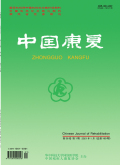中国康复2024,Vol.39Issue(6):323-328,6.DOI:10.3870/zgkf.2024.06.001
卒中后失语症患者失语症类型及严重程度影响因素的回顾性分析
Retrospective analysis of factors influencing the type and severity of aphasia in patients with post-stroke aphasia
摘要
Abstract
Objective:To analyze the relevant clinical data of post-stroke aphasia patients,including the relation-ship between lesion location,nature,gender,age,education,and the type and severity of aphasia.Methods:Clini-cal and imaging data,as well as WAB evaluation results,were collected from patients with post-stroke aphasia in the Inpatient Department of the Rehabilitation Medicine Department of our hospital from January 1,2019 to Decem-ber 31,2021.The correlation between aphasia types,WAB scores,and clinical data was analyzed.Results:The most common site of injury in patients with post-stroke aphasia was left cortical injury(31 cases,33.3%),followed by left basal ganglia injury(28 cases,30.1%).The severity of WAB was related to the location of the injury,and WAB with simultaneous cortical and subcortical damage had lower scores in terms of AQ,self speaking,listening comprehension,and naming(P<0.05).Further pairwise comparison revealed that patients with cortical and sub-cortical injuries had lower AQ,self speaking comprehension,auditory comprehension,and naming scores(P<0.05)than those with single subcortical injuries.AQ and overall WAB scores(self speaking,auditory comprehen-sion,retelling,and naming)were significantly lower than those with only subcortical injuries(P<0.05),and patients with other site injuries also had poorer AQ,auditory comprehension,and naming scores(P<0.05).The proportion of complete aphasia among pa-tients with ischemic stroke was significantly higher than that of hemorrhagic stroke,with a statistically signifi-cant difference(P<0.05).The AQ of patients with isc-hemic stroke was significantly lower than that of patients with hemorrhagic stroke(P<0.05).In terms of self speaking,listening comprehension,and retelling,the scores in ischemic stroke were significantly lower than those of hemorrhagic stroke(P<0.05),but named individual scores between the two groups had no significant differences.Age,gender and ed-ucation did not affect the type of aphasia and WAB score.Conclusion:PSA is most commonly associated with damage to the left cortex and basal ganglia.The type and severity of PSA are influenced by the location of the lesion and the nature of the stroke,rather than age,gender and education.The presence of damaged lesions in both the cortex+subcortical regions is more likely to lead to severe aphasia symptoms.关键词
卒中后失语症/失语症类型/失语症严重程度Key words
post-stroke aphasia/the type of aphasia/the severity of aphasia分类
临床医学引用本文复制引用
王瑜元,孙长慧,白玉龙..卒中后失语症患者失语症类型及严重程度影响因素的回顾性分析[J].中国康复,2024,39(6):323-328,6.基金项目
国家重点研发计划项目(2022YFC2009700,2022YFC2009706),国家自然科学基金委员会项目(82272607),上海市卫健委项目(201840225) (2022YFC2009700,2022YFC2009706)

